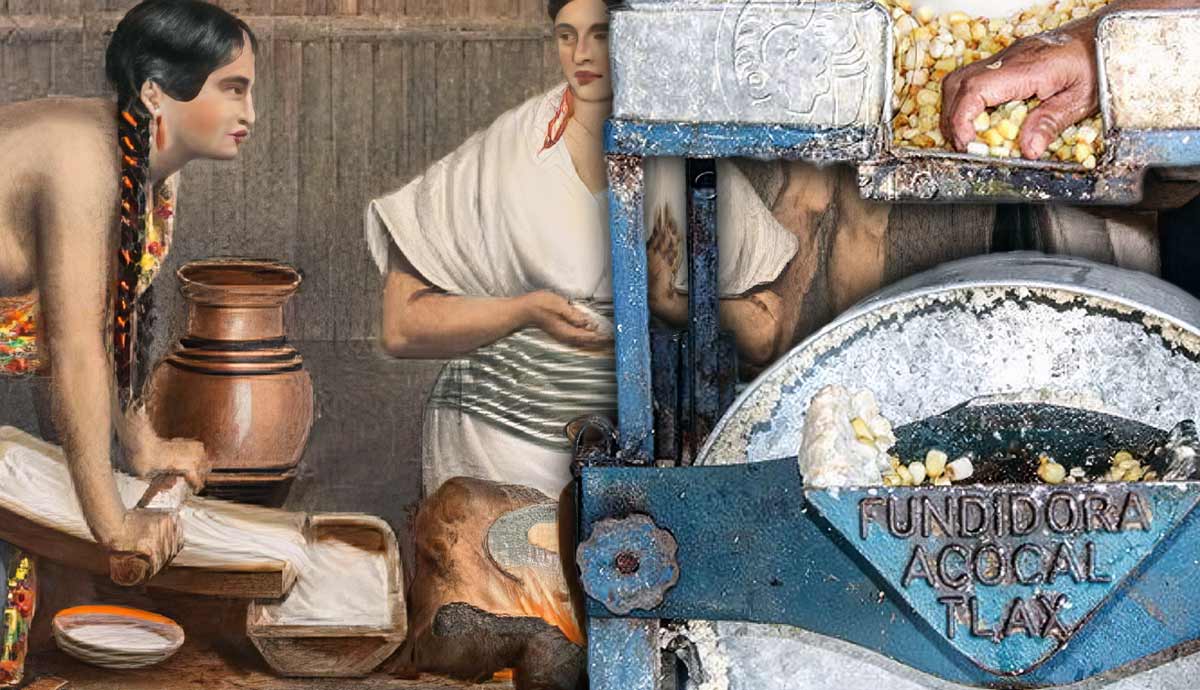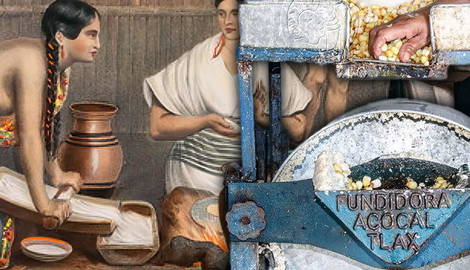
In the first half of the 20th century, a devastating pellagra epidemic struck the United States. At its peak, the epidemic caused more than 250,000 cases of illness and 7,000 deaths per year, primarily in the South. It also overwhelmed healthcare resources and exposed grave structural inadequacies in the nation’s food processing systems. As the epidemic worsened, pellagra became politically contentious due to its association with poverty. Of course, lost in the political milieu was the history of nixtamalization – an ancient form of pellagra prevention linked to arguably the most impactful example of bioengineering in human history: the creation of maize, also known as corn.
Nixtamalization: From Inedible Grass to Global Food Solution

According to archeological evidence, maize domestication began thousands of years ago in the Balsas Valley of Mexico, before the end of the 5th millennium BCE (Piperno, 2011). It was there that Indigenous Americans first bioengineered a wild grass called teosinte into the maize we know today. As a food source, teosinte and its early derivations were labor-intensive and unreliable foods thanks to their individually wrapped kernels and minimal nutritional value. Extensive human intervention was needed to convert the grass into a dependable crop. Through careful selection and controlled genetic mutations, ancient farmers developed teosinte into a cob of kernels covered by a single husk, increasing the volume of food and reducing the labor needed to harvest it. However, a significant drawback remained — humans could not fully digest maize.
While the invention of maize improved the volume of available food and reduced harvesting labor, it did not address the problem of nutrient accessibility. Due to maize’s high cellulose and insoluble fiber content, the human digestive system cannot access or absorb the nutrients contained in the kernels — a significant challenge to improving nutritional value. To address this problem, ancient American farmers invented nixtamalization — a sophisticated technique with far-reaching impacts on human development.
Exploring the Ancient Art of Alkaline Cooking

Nixtamalization is an old Indigenous technique dating back thousands of years. The process involves treating maize kernels with an alkaline solution to improve taste and nutrition. Cooking with alkaline to ferment, preserve, and detoxify foods is not a uniquely American practice, either. For thousands of years, human societies from Scandinavia to China have used alkaline substrates like ash, salt, and lye to preserve everything from fish to eggs. Even the ancient Romans fermented olives in wood ash to reduce their bitter taste (McGee, 2004). Anyone who has eaten a pretzel — made shiny thanks to lye — has enjoyed the results of these historical practices.
In pre-colonial Mesoamerica, nixtamalization involved cooking dried maize kernels with water and wood ash. In the modern era, lye and pickling lime are the preferred choices. Once the cooking finishes, the maize is drained and rinsed to remove the outer kernel shell. Then, it is milled, kneaded, and formed into nixtamal dough for cooking. Regardless of the components, the mixture of base and water results in a chemically and physically transformed version of maize — safe and fully bio-available to human digestive tracts.
From Nutrient-Poor to Dietary Staple: The Many Benefits of Nixtamalized Corn

Incredibly, the benefits of nixtamalization go beyond just nutritional absorption. The process also detoxifies maize kernels, neutralizes anti-nutrients, enhances protein quality, improves amino acid balance, and increases calcium content by up to 400%. Perhaps most importantly, it releases niacin from its natural form, making it available for absorption by the human body. Ultimately, given the numerous nutritional benefits, nixtamalized maize is one of the few foods capable of acting as a complete dietary staple for the human population.

In addition to the many health benefits, nixtamalization improves the overall quality of corn-derived foods. The process positively impacts flavor, aroma, and texture, making maize more desirable for daily sustenance. Furthermore, nixtamalized maize is easier to grind, reducing the workload involved in its preparation. In fact, some researchers believe these characteristics were key factors that helped popularize the practice of alkalizing food throughout the Americas. Thanks to these improvements, nixtamal — treated maize dough — continues to form the basis for many highly nourishing traditional Central American foods like tortillas, tamales, and atole in the modern era.
How Did Ancient Farmers Discover Nixtamalization?

The colonization of the Americas was exceptionally violent. A combination of disease, war, and forced assimilation destroyed vast quantities of Indigenous American history, leaving many questions about how and when ancient societies discovered nixtamalization.
Historically, the first mention of the practice comes from the Aztec Triple Alliance, as recorded by Bernardino de Sahagun (Coe, 1994). The word itself is a corrupted version of the Nahuatl word referring to the practice of grinding maize for masa, while mahiz — maize — is the Taino word used for their staple grain (Fussell, 1999).
It has been suggested that early American societies first consumed maize as a fermented drink, leading to its geographical dissemination through social networks. No matter its specific origins, there is overwhelming evidence that the practice of alkalizing food products with ash existed across Mesoamerica and the modern-day Southwestern United States in various forms since well before the arrival of European ships.
From Oaxaca to Turkey: Maize Goes International

The European colonization of the Americas was a disruptive event for Indigenous societies, European power dynamics and philosophies, and the global exchange of agricultural commodities. Native American cultures found themselves on the losing side of colonial ambitions. Meanwhile, maize — one of their most consequential inventions — became the cornerstone of the global industrial food system.
Facilitated by global trade routes established in the wake of European colonization, maize spread rapidly to every corner of the globe. So quick was the dispersion that by the early sixteenth century, most of the maize eaten in Europe was grown in Turkey (Fussell, 1999). As the rate of globalization increased, and with it the spread of industrial agriculture, corn-based products became ever more prevalent on grocery shelves from Canada to Indonesia.
Wherever Un-Nixtamalized Maize Went, Pellagra Followed

Unfortunately, European and North American industrial food processing techniques rarely included nixtamalization in the maize preparation process, with dire consequences for human health worldwide.
Without the crucial nixtamalization step, the niacin within maize remains bound up and inaccessible to the human body. Incredibly (and inevitably), the global spread of an agricultural product rich in niacin caused an explosion of pellagra — a disease caused by a dietary niacin deficiency.
Pellagra is a form of malnutrition plaguing populations that subsist on large amounts of un-nixtamalized maize. Symptoms range from chronic dermatitis to dementia. If left untreated, it will result in death (Hegyi et al., 2003). Pellagra spread throughout Europe following its appearance in Spain in the mid-1700s, preceded by native crop failures that forced peasant populations to depend on maize (Fussell, 1999). By the time the first British colonists landed on American shores, many were already familiar with the plant – but not the practice of nixtamalization. By the Great Depression, hundreds of thousands of Americans had succumbed to pellagra. The root of the problem was eventually identified, and measures were put in place to artificially enrich maize products with niacin; however, this solution ignored the additional health benefits of fermenting foods with alkaline substrates.
The Future of Maize: Can Nixtamalization Feed a Hungry World?

Today, the world’s population continues to grow, and demand for corn is increasing exponentially. As such, scientists dedicate significant time and resources to increasing maize production. From the use of insecticides to genetic modifications, the expansion of maize is a priority in agricultural research. However, according to some nutrition experts, there is a need to improve the nutritional potential of maize already in cultivation before further expanding production. According to food scientist Dr. Schindler, nixtamalization should be a non-negotiable step in industrial maize processing. “Maize is the most widely grown grain in the world. Just think about the impact that nixtamalizing every single kernel of it would have on our food supply.”
While the ancient science of nixtamalization may not yet be a mainstay of global industrial food systems, the practice continues to dominate culinary traditions across Mexico, Central America, and the Southwestern United States. Nixtamal products have also grown in popularity around the world, with artisanal tortillerías enthusiastically adopting the practice and customers increasingly favoring its complex, authentic flavor. Ultimately, this ancient Indigenous science is potentially an important tool for meeting the nutritional demands of an ever-growing population.
References
Coe, Sophie D. (1994). America’s First Cuisines. University of Texas Press, Austin.
Fussell, Betty. (1999). “Translating Maize into Corn: The Transformation of America’s Native Grain.” Social Research 66(1):41-65.
Hegyi, Juraj, Robert A. Schwartz, and Vladimir Hegyi. (2004). “Pellagra: Dermatitis, Dementia, and Diarrhea.” The International Journal of Dermatology 43:1-5.
McGee, Harold. (2004). On Food and Cooking: The Science and Lore of the Kitchen. Scribner, New York.
Piperno, Dolores R. (October 2011). “The Origins of Plant Cultivation and Domestication in the New World Tropics: Patterns, Process, and New Developments”. Current Anthropology. 52 (S4): S453–S470.









